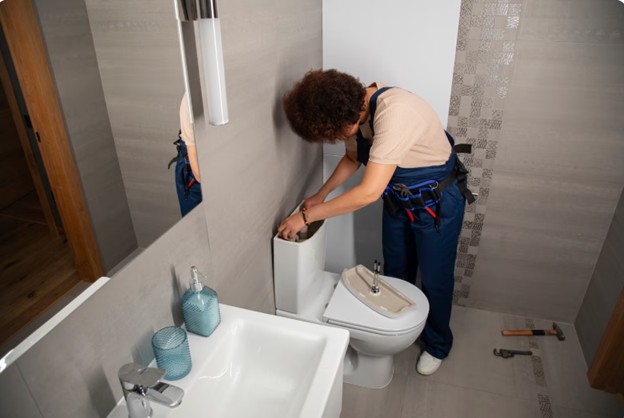Bathroom renovations offer the opportunity to create functional, beautiful spaces that add value to your home. However, poor planning and common oversights can turn dream projects into costly nightmares. Learning from the mistakes others have made can help you avoid similar pitfalls and ensure your bathroom renovations proceed smoothly from start to finish.
Inadequate Planning & Rush Decisions
One of the most costly mistakes in bathroom renovations is failing to create detailed plans before starting work. Many homeowners begin demolition without fully considering how their choices will impact daily life or long-term functionality. This approach leads to change orders, delays, and budget overruns that could have been avoided with proper planning.
Rushing material selections often results in regret later. Tiles, fixtures, and finishes should be chosen carefully, considering both current needs and future preferences. What seems trendy today may feel dated in just a few years, making timeless choices more practical for long-term satisfaction.
Take time to research local building codes and permit requirements before beginning work. Starting without proper permits can result in work stoppages, fines, and complications when selling your home. Building departments require permits for most bathroom renovations involving electrical, plumbing, or structural changes.
Underestimating Project Costs
Budget miscalculations plague many bathroom renovation projects. Hidden costs often emerge once work begins, including structural repairs, plumbing updates, or electrical modifications that weren’t apparent during initial planning. Adding a 15-20% contingency to your budget helps cover unexpected expenses without derailing the entire project.
Material costs can vary dramatically based on quality and source. While budget-friendly options may seem attractive initially, they often require replacement sooner and may not provide the performance needed in wet bathroom environments. Investing in quality materials for important components like waterproofing and plumbing fixtures prevents future problems.
Labor costs are frequently underestimated, particularly for specialized work like tile installation or custom carpentry. Getting multiple quotes from licensed contractors helps establish realistic budget expectations and identifies possible red flags in pricing or scope of work.
Poor Ventilation Planning
Inadequate ventilation creates long-term problems that extend far beyond bathroom renovation costs. Moisture buildup leads to mold growth, paint peeling, and structural damage that can affect entire homes. Proper exhaust fan sizing and placement are essential for maintaining healthy indoor air quality.
Many homeowners install undersized exhaust fans that can’t effectively remove moisture from their bathroom space. Fans should be sized based on room volume and provide complete air changes within appropriate time frames. Quiet operation is also important for user comfort and consistent use.
Exhaust fan placement affects performance significantly. Positioning fans near shower areas provides better moisture removal than central ceiling locations. Some bathroom layouts benefit from multiple exhaust points to ensure adequate ventilation throughout the space.
Ignoring Electrical Safety Requirements
Bathroom electrical work requires strict adherence to safety codes due to the presence of water and moisture. Ground Fault Circuit Interrupter (GFCI) protection is mandatory for all bathroom outlets and must be properly installed and tested. Many bathroom renovations require electrical panel upgrades to handle increased loads.
Lighting placement affects both safety and functionality. Insufficient lighting creates hazardous conditions, while poorly positioned fixtures create shadows that interfere with grooming tasks. Combining ambient, task, and accent lighting provides the best overall illumination.
Electrical work should be performed by licensed electricians who understand local codes and proper installation techniques. DIY electrical work often fails inspections and can create serious safety hazards that endanger occupants and void insurance coverage.
Plumbing Mistakes & Water Damage
Moving plumbing fixtures during bathroom renovations can be expensive and difficult. Relocating toilets, sinks, or showers may require significant structural modifications and professional engineering evaluation. Working with existing plumbing locations when possible reduces costs and complications.
Waterproofing failures cause extensive damage that may not become apparent for months or years. Proper membrane installation behind tile surfaces and around shower areas requires specific products and techniques. Cutting corners on waterproofing materials or installation methods creates liability for costly repairs later.
Water pressure and flow rate considerations affect fixture performance and user satisfaction. Installing multiple high-flow fixtures without adequate supply lines results in poor performance and user frustration. Upgrading supply lines during renovations prevents these problems.
Storage & Functionality Oversights
Failing to plan adequate storage leaves bathroom renovations feeling incomplete and cluttered. Medicine cabinets, linen storage, and vanity organization should be considered during the design phase, not added as afterthoughts. Built-in storage solutions provide better space utilization than freestanding furniture.
Towel storage and hooks are often overlooked until projects are nearly complete. Planning towel hanging locations, heated towel bars, and storage for clean linens improves daily functionality significantly. These elements should be integrated into the overall design rather than added later.
Accessibility considerations become important as homeowners age. Grab bars, shower benches, and curbless entries are easier to incorporate during major bathroom renovations than to retrofit later. Planning for future needs prevents the necessity of additional renovation projects.
Tile & Grout Selection Errors
Choosing inappropriate tile materials for bathroom applications leads to maintenance problems and safety concerns. Floor tiles must provide adequate slip resistance when wet, while wall tiles should resist moisture penetration. Some natural stone materials require sealing and special maintenance that many homeowners aren’t prepared to provide.
Grout selection significantly impacts long-term maintenance requirements. Light-colored grout shows stains and discoloration more readily than darker alternatives. Epoxy grout costs more initially but provides better stain resistance and requires less maintenance over time.
Large format tiles can create stunning visual effects but require completely flat surfaces for proper installation. Subfloor preparation becomes more important with larger tiles, and lippage (uneven tile edges) is more noticeable. These installations often require professional expertise to achieve acceptable results.
Contractor Selection & Communication Problems
Hiring unlicensed or uninsured contractors creates liability and quality concerns that can affect entire bathroom renovation projects. Licensed contractors carry insurance protection and are accountable to licensing boards for their work quality. Always verify licensing status and insurance coverage before signing contracts.
Communication breakdowns between homeowners and contractors cause delays, change orders, and unsatisfactory results. Clear written contracts should specify materials, timelines, and payment schedules. Regular progress meetings help identify and resolve issues before they become major problems.
Getting multiple quotes allows comparison of approaches, materials, and pricing. The lowest bid isn’t always the best value, particularly if it excludes necessary work or uses inferior materials. Evaluating contractor experience with similar projects provides insight into their capability and reliability.
Timeline & Living Situation Challenges
Underestimating project duration affects family routines and daily life significantly. Bathroom renovations typically take longer than expected due to permit delays, material delivery issues, or hidden problems discovered during demolition. Planning alternative arrangements for bathing and daily routines reduces stress during construction.
Sequencing work properly prevents delays and conflicts between different trades. Electrical and plumbing rough-in must be completed before drywall installation, while tile work comes after waterproofing. Knowing these sequences helps homeowners recognize when projects are progressing appropriately.
Managing dust and debris during bathroom renovations protects other areas of the home and improves air quality. Proper containment measures and regular cleanup maintain livable conditions throughout the construction process. These considerations become more important in occupied homes with children or elderly residents.
Learning from these common mistakes helps ensure your bathroom renovations proceed smoothly and deliver the functional, beautiful results you envision. Proper planning, quality materials, and experienced professionals provide the foundation for successful projects that add value and enjoyment to your home for years to come.

